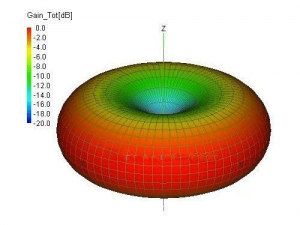Antennas have different radiation or receiving capabilities in different directions in space, which is the directivity of the antenna. Depending on the directivity, there are two types of antennas: omnidirectional and directional.
Omnidirectional Antenna:
Omnidirectional antenna, it is shows uniform radiation at 360° on the horizontal pattern, which is commonly referred to as non-directional. In general, the smaller the lobe width, the greater the gain. Omnidirectional antennas are generally used in communication systems with short distances, large coverage areas and low prices. The gain is generally below 9dB. The figure below shows the signal radiation pattern of an omnidirectional antenna. (The radiation range of the omnidirectional antenna is more like an apple)

Directional Antenna
Directional antennas show a certain angular range of radiation on the horizontal pattern, which is usually said to have directivity. Like the omnidirectional antenna, the smaller the lobe width, the greater the gain. Directional antennas are generally used in communication systems where the communication distance is long, the coverage area is small, the target density is high, and the frequency utilization rate is high.
From the point of view of gain, there is no difference between the two antennas, but there is a very important point: Because of its sharp pointing, the directional antenna is well shielded from the interference signal from the pointing out, which is also very useful for evaluating the receiving effect. Important indicator! We can also think about the relationship between omnidirectional antennas and directional antennas in this way: omnidirectional antennas will transmit signals in all directions, and the signals can be received front, back, left, and right. The directional antenna is like a strong reflective surface behind the antenna. , The signal can only be transmitted to the front, and the signal to the back is blocked by the reflective surface and reflected to the front, which strengthens the signal strength in the front. (The main radiation range of the directional antenna is like an inverted, incomplete cone)

Through the above analysis, we can visually recognize what is an omnidirectional antenna and what is a directional antenna. So what should be paid attention to in actual application?
If the antenna selection needs to meet multiple sites, and these sites are distributed in different directions of the AP, omnidirectional antennas are required; if they are concentrated in one direction, it is recommended to use directional antennas; in addition, consider whether the antenna joint form is compatible Whether the AP matching and antenna gain size meet your needs; the antenna installation For outdoor antennas, lightning protection equipment needs to be added between the antenna and the wireless AP; for directional antennas, pay attention to the front of the antenna facing the direction of the remote site; the antenna should be installed At the highest possible position, the line of sight between the antenna and the site is as high as possible (visible to the naked eye, avoid obstacles in the middle).

